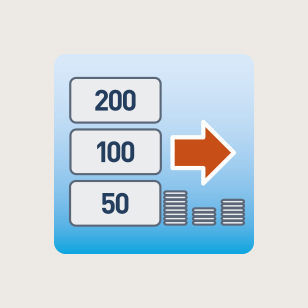Editor’s note: This is a guest post from Richard Cop from Interact Consulting
Give workflows a miss: A provoking claim in the age of business process automation. Because whenever we think of the automated processing, we think in categories of how information gets to the relevant persons fast and efficiently. But especially when it comes to automated processing of vendor invoices, this consideration is the wrong approach, because it is necessary to automate processing as far as possible so that only a small amount of invoices have to be sent on a control and approval journey actually using a workflow.
All beginnings are easy
Whenever we are addressing the subject of automated invoice processing in a first meeting with a customer, our counterpart talks workflow. Traditionally the incoming electronic or scanned image of an invoice is received in accounting. They then determine the responsible person, sends the invoice and waits for the respective invoice release. After its return to accounting, booking, filing and payment are carried out and that is all.
This may be a good approach when you are dealing with very few invoices, maybe five to at most ten units per day respectively less than 2.000 invoices per annum. In addition, dealing with this amount, an existing e-mail system and a bit of organizational aptitude should be sufficient to keep track. However, as soon as the number doubles, triples or even quadruples, such an approach reaches its limits shortly, because all the sudden a staff member of the accounting department will spend most of its working day sending invoices on their electronic journey and controlling the returned invoice approvals.
Therefore, when it comes to invoice quantities of 10.000 units or more, a better alternative has to be considered. One that avoids wait time and grants full overview over all invoices in circulation. So at first glance, implementing a workflow-system seems obvious. A system that offers the possibility to track the invoice distribution and intervene in the process at any time. However, is this sufficient? Or is it rather a missed opportunity?
Invoices are a bonanza
A workflow can be a good thing, but honestly: Does it not seem absurd to you, too, to send an invoice that you receive on a monthly basis to the same person time and again and subsequently use the same old data over and over again for accounting? In this case, would it not be much more feasible if the system carried out such processes on its own?
In order to enable an intelligent processing system to do so, it has to be provided with high-quality data at a very early stage. Therefore, at the beginning of an automation process paper invoices, on the one hand, have to be scanned and recognized or automatically read, the delivered data records of electronic invoices, on the other hand, have to be reformatted into a standard format, so that all further processing steps can be executed uniformly.
Once the invoice data is available in a consistent electronic way, it can be processed automatically. The objective of an optimized business process automation has to be to store knowledge in such a way that data can be processed highly automatically, or in other words, whenever possible without human intervention.
When analyzing your everyday invoices, you will quickly realize that a large number of it is returning. This means that information and knowledge on how to deal with these invoices is present within your organization. This knowledge can be stored in systems or inside the heads of your staff. In case this process is to be automated, it is important to use this information and to prepare it in such a way that the processing system can take highly independently all necessary decisions based on this knowledge.
For example, there is project ABC and it is know that the invoices of supplier XYZ always belong to this project and that they are always booked the same way. At the same time, these invoices are checked and approved by the ever-same person of the ever-same department. The binding source for the invoice checking is the corresponding contract negotiated with supplier XYZ for project ABC.
It does not make any sense to enter this information into the accounting system time and again whenever the invoice comes in. In addition, it is equally useless to e-mail this invoice to the ever-same person hoping she or he will return the approval before the cash discount period has expired.
In this case, we are speaking about an automated workflow where the basic information of a vendor is stored in the processing system and used automatically as accounting and approval template whenever such an invoices comes in. However, processing invoices that way implies that the invoice recognition is carried out consistently, by way of example using the unique vendor master record of the accounting system.
Why do contracts exist?
The cynical answer could be: So that they can be discarded somewhere and forgotten until someday the big search begins. Well, hopefully not, but in most of the companies that we have met so far, there is no or an only very limited structured contract management. Because of this, goods and services are often only vaguely known and simple information such as period or term of notice is not available on short notice. In case contracts are recorded in a system in a structured way, the information contained can be used to automate the processing of all invoices by the respective contracting party. Generally, terms of credit, rates and conditions, installment plans, periods, budgets et cetera are defined in the contract, so that the electronically available invoice data can be matched with the respective contract information.
Generally, if there is an existing leasing or rental agreement it is known when the respective invoices come in, which amounts have to be paid and how they have to be recorded. In case no deviation from the contract is discovered, there is absolutely no need for a check and approval process. Letting these invoices be checked and approved by the ever-same person time and again and to record them in the ever-same way is nothing more than a waste of precious time.
For contracts with variable invoice amounts, similar procedures can be applied. By way of example, checking the often-comprehensive telephone bills is feasible only when there is a peculiarity respectively a deviation such as an extraordinary invoice amount. Therefore, effectively automating the processing of invoices with contract reference requires the use of such procedures in order to process these recurrent invoices fully automatically and to detect deviations so that your specialists can systematically focus on these peculiarities.
An order is already entered in the books
The potential of automating invoices with order reference goes even further. Many organizations operate standardized purchasing systems that manage the orders of goods and services. Generally, requisition, approval, process of quotation and finally placing the purchase order with the supplier are part of the things managed by such systems. In addition, an approval process of the desired order is an essential part of this procedure. Furthermore, all relevant information regarding prices and conditions, accounting, cost centers, projects et cetera is already deposited when placing the order. Therefore, it does not make any sense at all to run through these steps all over again and to manually check and record all information again by the time the invoice arrives.
Using automated order matching, the processing system checks whether there is a deviation between invoice and order. In case no deviation is detected, there is no reason to manually check the respective invoice and run through an approval process all over again. This a complete waste of precious time, too.
The workflow spiral
And yet it moves, the workflow spiral. However, only for the few invoices that are sent by (still) unknown suppliers or do not have either contract or order reference. As far as we know, in a well-positioned organization these kinds of invoices only represent a very small part that often lies in a single-digit percent range. Making a workflow system the heart of an automation project because of this small amount of invoices and thereby renouncing the actual automation potential is as wrong as missing cash discount periods. In short, it is a missed opportunity.
(This post appeared first in Interact Magazin on the Interact homepage in German)
####
DR. RICHARD COP is co-founder and CEO of Interact Consulting: «Which impact does technology have on our society and which impact do we have on technology? These questions take center stage for me and I also dealt with them in my dissertation on the process of structural change in telecommunication. I want to optimize processes, harmonize technology, organization and people, and above all, promote interaction. Therefore, as entrepreneur, today I design fully integrated processes together with our customers.»



